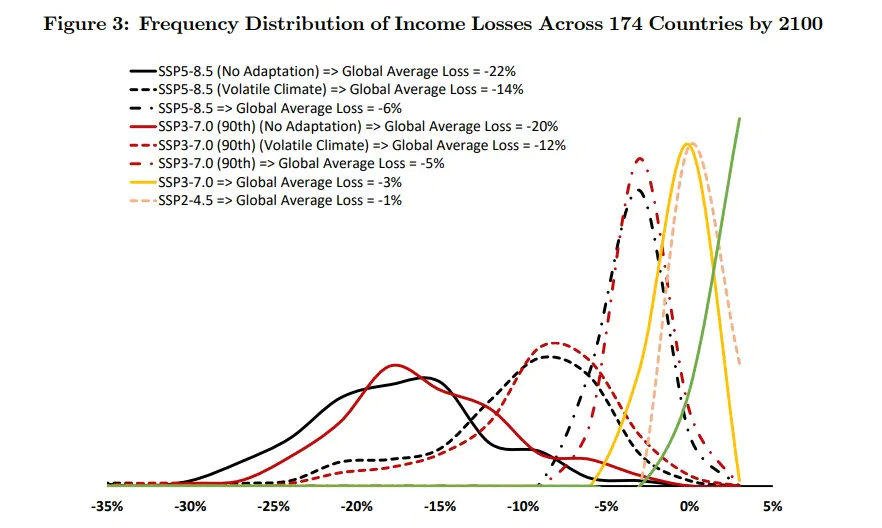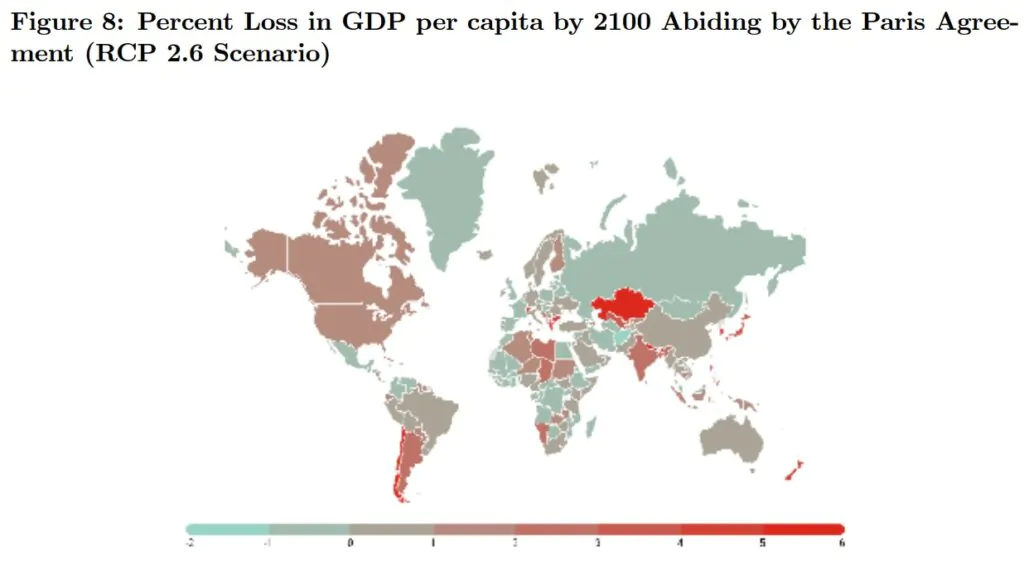Business and economics, Issue 15/2024
Who benefits from climate change adaptation?
If the bleakest scenarios for further increases in greenhouse gas levels were to come true, by 2100. the global economy could shrink by up to 24 percent. – warn researchers at the University of Cambridge. Disaster in the fight against rising temperatures will leave its mark on all regions of the world, but the Middle East and Africa have the most to lose. On the other hand, this is where successful adaptation to climate change could result in the highest per capita GDP growth.
Rising temperatures, melting profits
Published in June this year. the results of a study by researchers at the University of Cambridge show the macroeconomic effects of different climate scenarios on 174 countries around the world. They are based on calculations made five years earlier in a study carried out for the International Monetary Fund (IMF). The main objective is to try to quantify the impact that either passive or active adaptation to climate change will have on economic development in different regions of the world.
Rising temperatures, changes in precipitation intensity and increasingly frequent weather extremes are a major challenge to the global economy. However, the scale of their impact is not the same everywhere. A country’s geographic location and level of wealth appear to be crucial to the long-term consequences of climate change. The Cambridge researchers set out to expand on earlier IMF analyses by adding the impact of various mitigation and adaptation measures and meteorological fluctuations.
The results are no surprise. Further reductions in greenhouse gas emissions, combined with multi-directional adaptation to climate change, are key to ensuring economic prosperity for future generations. However, lower-income countries and those in warmer climates will be particularly affected by this dependence.
Possible climate scenarios
The Intergovernmental Panel on Climate Change (IPCC). The Intergovernmental Panel on Climate Change (IPCC) has prepared a series of scenarios for the further development of the situation on Earth depending on the level of greenhouse gas concentrations in the atmosphere. For the purpose of analysis, four significantly different variants were adopted – from RCP 2.6, which corresponds to the lowest possible level of emissions, to the black scenario RCP 8.5, which predicts a drastic increase in the amount of greenhouse gases in the atmosphere. At the same time, they were assigned five possible socioeconomic development paths, which include aspects such as population, education levels, urbanization and economic growth.
Effectively reducing emissions in line with the Paris resolutions is, of course, the optimal scenario for the whole world. Unfortunately, scientists point out that contemporary policies in many countries are not in line with the chosen emission targets, which could drastically accelerate global warming. Two scenarios are cited as particularly dangerous: a further increase in the use of fossil fuels and a reversal of pro-environmental national strategies due to political pressure.
Continued and long-term warming of the climate above the historical average results in lower economic growth, an IMF analysis makes clear. If we fail to curb greenhouse gas emissions and the global temperature rises by 0.04°C per year, global GDP per capita in 2100. will decline by 7 to 13 percent. relative to a scenario in which temperatures would rise according to trends observed between 1960 and 2014. However, if the Paris Agreement could be implemented and the annual temperature increase limited to 0.01°C, the economic loss would be only 1 percent.
Slow adaptation to climate change will be costly
The slowdown in economic growth, depending on each country’s specific climate projections and adaptation efforts, will reach very different values at the beginning of the 22nd century. Globally, the most optimistic scenario predicts a decline in GDP per capita of 1 percent, while high emissions combined with a lack of adaptation to climate change are expected to reduce it by as much as 24 percent.
A large loss of 14 percent is also predicted in a scenario in which the weather becomes volatile and unpredictable. According to IMF experts, steadily rising global temperatures are not the only element of economic climate risk. An anomaly in the form of heat and cold waves, droughts and floods, as well as other natural disasters, could reduce profits in most economic sectors, especially agriculture, construction and trade.

In countries with hot climates and low income levels, per capita GDP losses can be 30-60 percent. greater than the global average. If the use of fossil fuels increases, they will be felt as early as 2050. and will range from -6.3 percent. for Tunisia to -9.6 percent. for Oman and the United Arab Emirates. If adaptation to climate change were to accelerate markedly, the loss in GDP per capita could amount to approx. -0.4 percent.
In countries with cool climates, which include Poland, the loss of GDP due to global warming will be by approx. 40 percent. smaller than the global average, but they cannot be ignored. Over the Vistula, the economic loss per capita in 2103. is expected to be -0.14 percent. in the case of the most favorable climate scenario and -18.97 percent. in the event that the bleakest of forecasts develops.
Middle East and Africa have most to gain
Looking at the reality from a more optimistic side, rapid and effective adaptation to climate change can bring very tangible economic benefits in some regions of the world. In the positive scenario of a fundamental reduction in atmospheric concentrations of greenhouse gas emissions (RCP 2.6), while taking adaptation measures, countries in the Middle East and Africa can expect economic growth as early as 2050. (at an average level of about 0.3 percent).
A detailed macroeconomic analysis of the situation of individual countries at the beginning of the 22nd century. also offers hope. In an optimistic climate scenario in 2103. Afghanistan, El Salvador, Guatemala, Libya and Tunisia can expect per capita GDP growth of more than 1 percent. In Yemen, Uganda, Trinidad and Tobago, Togo, Sudan, Qatar, Namibia or Somalia, GDP growth would likely exceed 0.6 percent. In Europe, a greener future will benefit economically mainly Spain, Slovenia, Bosnia and Herzegovina, Italy and Croatia. It is worth noting that for the larger economies, a difference of even several tenths of GDP translates into profits in the billions of dollars.

In the study’s conclusions, the Cambridge researchers emphasize that, when implemented resiliently enough, adaptation to climate change appears to be an effective way to reduce its economic costs. At the same time, they stress that even the most ambitious adaptation efforts will not be able to completely neutralize the economic impact of global warming. Thus, they call for strengthening and accelerating international mitigation efforts, especially in the context of more actively reducing greenhouse gas emissions.

 Polski
Polski







